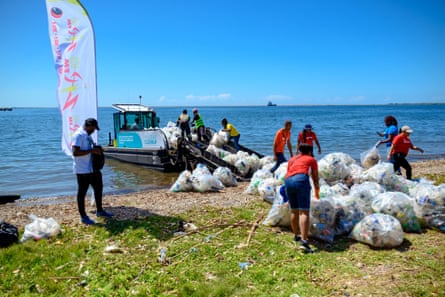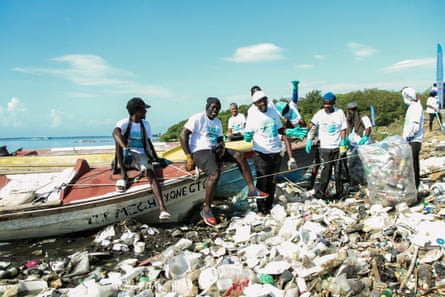Kingston, Jamaica, boasts the world’s seventh largest natural harbour, at nearly 10 miles long by two miles wide. Trade has thrived here for hundreds of years. In 1720, this was where British colonialists hung and gibbeted John “Calico Jack” Rackham, often cited as inspiration for Captain Jack Sparrow in Pirates of the Caribbean.
In the 20th century, up until the late 1980s, it hosted an annual cross-harbour race. These days, however, swimming here is ill-advised. The city’s waste management systems struggle to cope with the volume of waste Kingston produces, with several gullies from communities around the city’s edge running directly into the harbour.
When it rains, waste from communities and businesses as far inland as the foot of the Blue Mountains is pushed out into the harbour. That presents a massive pollution problem – a problem the Kingston Harbour Cleanup Project (KHCP) plans to tackle.

Launched in 2021, it has now collected more than 1.3m kg of waste. But the KHCP is not typical of such projects: it is based on sustainable technology and incorporates barrier solutions pioneered in the Netherlands. More than this, it is all being done in close collaboration with the local community, private companies and nonprofit foundations.
Clean Harbours Jamaica’s managing director, Michael McCarthy, describes the project as a shared vision. “We got in touch with the GraceKennedy Foundation [a Jamaican corporate body that gives grants for projects] two years before launch, and it was a no-brainer because our visions align. We both want a sustainable environment model for the harbour. We both want to see it back in its glory,” McCarthy says.
The barrier systems have little impact on plastic already polluting the deep ocean, but the ones in Kingston Harbour are designed to intercept new waste from going into the ocean. An interceptor tender vessel cleans the collected trash from the barriers anchored at the mouth of the gullies of the almost landlocked harbour, and is crewed by local people who have learned their skills on fishing boats.

Waste harvested from the barriers is then brought ashore and sorted. “Things that can be recycled are picked up by the Recycling Partners of Jamaica, and the Carib company [Caribbean Cement Company] re-uses those that cannot be recycled,” says the operations manager, Alecia Rose-Beaufort.
Kingston Harbour is a case study in ocean pollution, with its complex system of gullies designed to act as outlets for storm waters. According to Rose-Beaufort, this has already inspired ingenuity in solutions. “So far, we have two types of solutions: the barriers meant for deep waters with larger surface area, and those meant for more shallow waters such as this gully beside our HQ.”
The project currently covers five gullies, and there are plans to expand to other locations in Jamaica such as Montego Bay. “We’ve had an outpouring of requests, which shows that they need something like this. It’s scalable and sustainable locally and internationally,” says McCarthy. If this project shows it can work, he says, it has potential for other coastal cities around the Caribbean.

A key part of the project has been the partnerships struck, including with the office of the prime minister, the Port Authority of Jamaica, the National Environment and Planning Agency and fishers from Rae Town and Port Royal. Schools bring their students for educational tours; community members are recruited as staff, but also taught new maritime skills and given the chance to formalise the ones they have.
The programme is offering local people training on the importance of the environment and waste management, and encouraging them to sign up to become tour guides certified under Jamaica’s Tourism Enhancement Fund.
“If community members don’t view it as their own initiative, success is much lower. We need them to care, protect and report on what’s going on, so we established the environmental warden programme,” says Caroline Mahfood, CEO of the GraceKennedy Foundation.
The foundation has a history of charitable and environmental initiatives including a mangrove restoration project along the Barnes Gully communities. GraceKennedy, the consumer foods company that set up the foundation, wants to reduce waste and reinforce its ties to downtown communities. “The funding for this project isn’t about behavioural change – it’s about the technology. But we wanted to add more because we felt it would be critical to the success,” says Mahfood.

The project in Kingston serves as a public and private sector pilot project that can be applied in other parts of the world. The Ocean Cleanup, a nonprofit environmental engineering organisation based in the Netherlands and founded by Boyan Slat, a 29-year-old entrepreneur, needs good results, as some critics consider the initiative costly and misdirected.
In Jamaica, McCarthy says that expansion of the project, with deployment of a new barrier, will happen in a matter of weeks. In times of climate crisis, he considers that developing new technologies is essential, especially given the risk of flash floods in the rainy seasons, when the volume of waste washed into the gullies is continually rising.
Although the KHCP’s efficacy has yet to be proven, it has a full plate as it continues to expand, McCarthy says. Jamaica offers a unique terrain that can help solve a global problem, he says, giving Kingston Harbour a new chapter in its long and colourful history.
